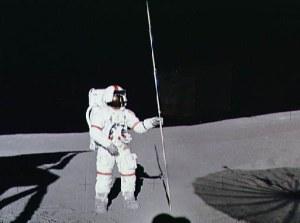Lunar leaper
Gravity on the Moon is about 1/6th that on the Earth. A
pole-vaulter 2 metres tall can clear a 5 metres pole on the Earth.
How high a pole could he clear on the Moon?
Problem
Image

The strength of gravity on the Moon is about 1/6th that on the Earth. A pole-vaulter around 2 metres tall can clear a bar about 5 metres from the ground on the Earth.
Roughly how high a bar could the pole-vaulter clear on the Moon?
Getting Started
Think about conservation of energy.
Student Solutions
Andaleeb of Woodhouse Sixth Form College sent in this correct solution. He takes account of the fact that pole vaulters only have to lift their center of gravity to roughly the height of the bar in order to clear it. Another correct solution was received from Christopher of Sidcup, Kent.
Since the man is 2m tall, his centre of mass is roughly 1m from the ground.
Let $h =$ height from the centre of mass to the highest point of clearing. Then on the Earth, $h = 5 - 1 = 4$ metres. Using conservation of energy, we get: $$\frac{1}{2}mv^2 = 4mg$$ where $v$ is the linear velocity moving horizontally only. Thus $$v^2 = 8g$$ Since the man is moving horizontally only (no vertical component of velocity is present) his velocity is not affected by gravity. Thus, $$v_{Earth} = v_{moon}$$ Applying conservation of energy on the moon, we get:
\begin{eqnarray} \frac{1}{2}m(8g) &=&
m\frac{g}{6}h \\ \Rightarrow h &=& 24. \\
\end{eqnarray}
Thus on the moon, the pole vaulter can clear a pole of height 24 +
1 = 25m. Teachers' Resources
Why do this
problem?
It requires clear thinking about the principles involved to decide what effect the change of gravity will have on the motion.
Key question
What can you say about the velocity of the pole vaulter when he is at the highest point of his vault?
It requires clear thinking about the principles involved to decide what effect the change of gravity will have on the motion.
Key question
What can you say about the velocity of the pole vaulter when he is at the highest point of his vault?
